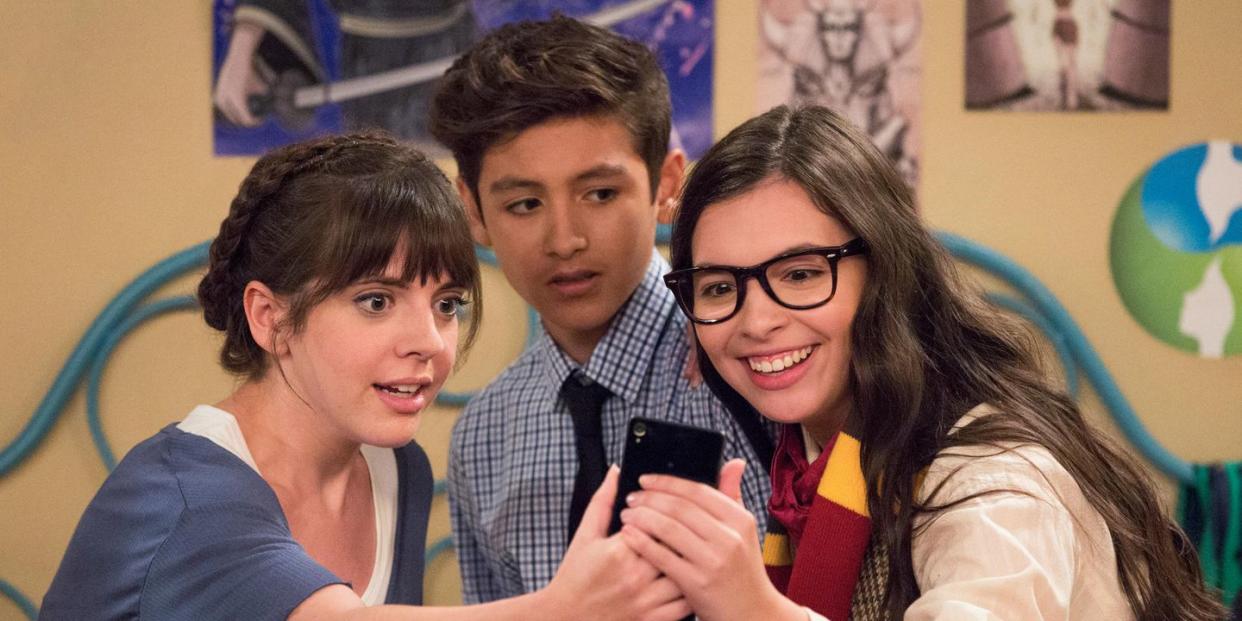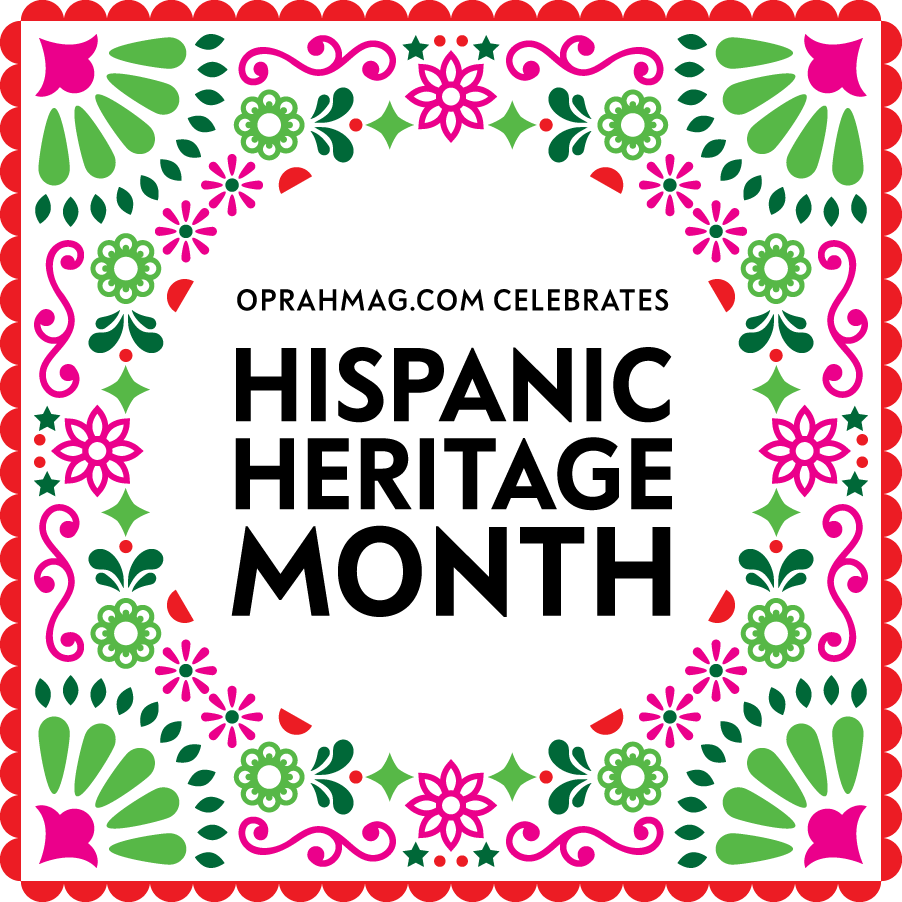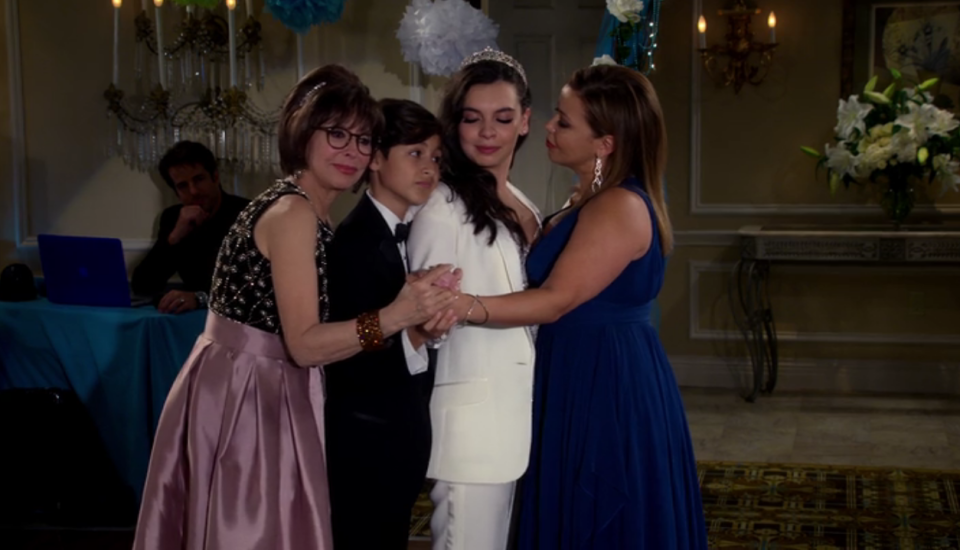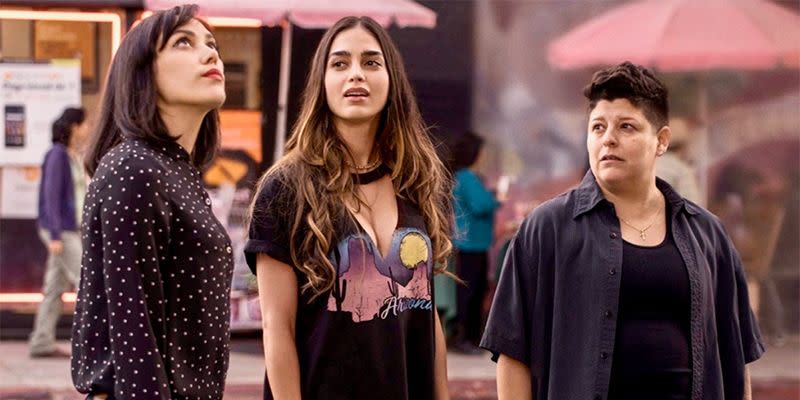Today's Queer Latinx Representation On TV Is Everything I Needed Growing Up

I was 13 years old when I first began to seriously question my sexuality. I’d always had minor crushes on girls, but I thought it had more to do with wanting to be like them, rather than be with them. In the late '90s, television was my greatest source of comfort—the place were I went to to find versions of myself reflected back at me. The only queer woman I ever saw on screen, however, was Ellen Degeneres. And while I thought she was hilarious, as a Latina, I didn’t really feel much of a connection to her.
The following year, when I finally came to terms with my sexuality and began to come out to friends, the only relatable character on TV that I could find was Rickie Vazquez, the openly gay Latino best friend played by Wilson Cruz in old reruns of My So-Called Life. It was a difficult and isolating time. I had no idea where I fit in, who to talk to, or what to do about any of it.

It wasn’t until many years later, as an adult, that I would begin to find glimpses of “me” on-screen. In my early 20s, I would watch Grey's Anatomy’s Callie Torres. Played by Sara Ramirez, Callie was a Latina doctor who comes out after a failed marriage and ends up having a family with the female love of her life. In one scene, she confronts her father with the truth about her sexuality; he tells her it’s an “abomination,” and that she’ll spend “an eternity in hell.” It reminded me of when I was outed to my religious Latina mother—though in my case, I didn’t have the strength Callie did to own her truth. It felt good to be seen not only through a coming out story, but through the lens of a Latina, one raised in a Catholic household as I was, with parents who also couldn’t quite grasp how terrifying it can be to come out.
Seeing Callie on-screen was the first time I realized how important representation can be. For marginalized kids like myself, it can be hard to grow up without allies or anyone who understands our position. Growing up in the late 90s, I was the first openly bisexual girl that I knew of in my middle school—and people openly hated me for it. Kids would avoid me in the halls, say terrible things, and play mean tricks on me. I became depressed and anxious, struggling with suicidal ideation. There was no Callie Torres to give me hope during my off time. I didn’t have any examples to show me that someday I could be a successful, happy, woman who also happened to be queer.
But in 2019, there are more positive representations of the queer Latinx experience than ever before—a gift for today's youth. I absolutely love the show Pose, which boasts a cast mainly composed of queer and trans people of color. Then there’s the new Charmed reboot, which returned for season 2 this month, featuring Melonie Diaz as a queer Latina. And many friends have also told me how much they absolutely love Brooklyn 99’s character Rosa Diaz, played by Stephanie Beatriz, who is also bisexual in real life.

And two years ago, I began watching a show that would've been a gamechanger for me as a teen. The beloved sitcom One Day At A Time (formerly on Netflix, coming soon to Pop) created by Gloria Calderon-Kellet, features a young, queer Latina character: Elena. “When I think about love, I see myself loving a woman,” the teenager tells her mother in one scene. While it takes both her mom and her abuela a little time to get used to the idea, eventually they come around and support her—because that’s what good parents do.
Things don’t go as smoothly with her father, who ends up (spoiler alert) stranding her in the middle of the father-daughter dance at her quinceañera party. In a later scene, however, she confronts her father and lets him know how much he’ll miss out on in his daughter's life because of his bigotry. This time, he finally admits how wrong he was and hugs her close. As a thirty-something-year-old, this scene made me like a baby. And I’m not alone.
“I literally cried my eyes out while watching the episode where Elena chooses to wear a pantsuit as her quinceñera outfit,” says Cindy Toscano, a program assistant at the Center for Women and Gender Equity at Bowling Green State University. Toscano, who is a lesbian, tells me she opted out of her own quinceañera because she didn’t know how to explain to her parents her desire to skip the dress. “While that instance in the show may seem insignificant for some people, for the 10-year-old tomboy that grew up not seeing anything like that on TV, it meant everything.”
Amy Quichiz, founder of Veggie Mijas—a collective for plant-based women and non-binary folks of color—says it wasn’t until she saw Carmen Morales (played by non-Latina actress Sarah Shahi) on The L Word in 2005 that she had someone to look up in pop-culture.
“She had my skin color and showed so much sweetness with her partner,” says Quichiz. “But it still wasn’t a healthy relationship, which was discouraging.” Members of the queer community like myself are all-too-familiar with stereotypes like the “psycho lesbian” and “depraved bisexual” on TV; similarly, the majority of queer storylines—like My So-Called Life’s Rickie Vasquez—are often about the aftermath of coming out. Film critic Yolanda Machado points out that characters like Rickie were important for opening doors—but it's important for culture to evolve.
“Rickie's whole arc was just dealing with the trauma of being queer, and that character is iconic—but we're finally seeing that change," Machado says. "Now we see Latinx queer people can be close to their families, be religious, fall in and out of love, with storylines about them as a whole person."
Starz' Vida is an example of just that. The breakout hit was created by Tanya Saracho, herself a queer Latina. Saracho has effectively written a show that depicts a variety of Latinx and queer experiences—because, of course, we don’t all have one homogenous existence. Main character Emma (played by actress Mishel Prada) is a semi-closeted queer woman who was initially kicked out of her home for her sexuality—only to later find that her mother, now deceased, was also queer.
Throughout the show, Emma dispels notions that you have to wave a rainbow flag in order to identify as queer (though, obviously, that’s fine, too). And she doesn’t hesitate to call out people who say she isn’t “queer enough” while refusing to label anything unless she feels like it. As a queer woman married to a cis-man, I’ve often not felt “queer enough”—and with each episode, I love how Saracho brings this issue to light.

Latina filmmaker Ana Lydia Monaco points out that TV is becoming more diverse for members of the queer Latinx community thanks to people who are are working hard to ensure stories are not inclusive just to check off a box, but to instead provide “a mirror of our worlds.”
“All of my films, stories, and pilots have diverse characters,” says Monaco, who is Mexican American and has been in the business for over a decade. Monaco lists her award-winning pilot script El Lay as one example, in which the lead’s brother is a closeted gay male. “The character was inspired by the many Mexican American men I've met that can’t come out to their families, so they live a double life. In our community, we know that kind of story all too well."
The thing about representation in pop-culture is that it helps you not only form part of your own self-identity, but also how you accept others. More queer Latinx representation means straight kids might watch shows like One Day at a Time or Brooklyn 99 and think twice before tormenting the queer kid in their class. It also means that parents might stumble upon them and recognize the struggles LGBTQ+ people face. We don’t want to be cast out of our homes. We don’t want to be told we are evil or bad for simply loving who we do. We just want to be.
“Our culture is beautiful, but it still has a long way to go for acceptance and equality," adds Machado. "Representation on-screen, doesn't just further our stories...it helps bridge the gap between younger and older generations who were raised in a very close minded and non-accepting way."
Perhaps if I’d seen more queer, bisexual, and sexually-fluid Latinx characters like Elena and Emma growing up, I would have never have been bothered by getting teased in the hallways, or felt the need to be “queer enough” as an adult who has loved people of various genders. Alex Hernandez, a medical interpreter in Dallas, Texas, agrees.
“Growing up in Mexico didn’t provide me with healthy queer representation on TV; most queer people were usually used as a punchline or as a cautionary tale,” she says. “Nothing terrified my 13-year-old self more than seeing the gay son being kicked out of the house in an over dramatic after-school special. So now that I’m older, I’m delighted to see more queer women like me on TV.”
Me, too, hermana. Me, too.
For more stories like this, sign up for our newsletter.

